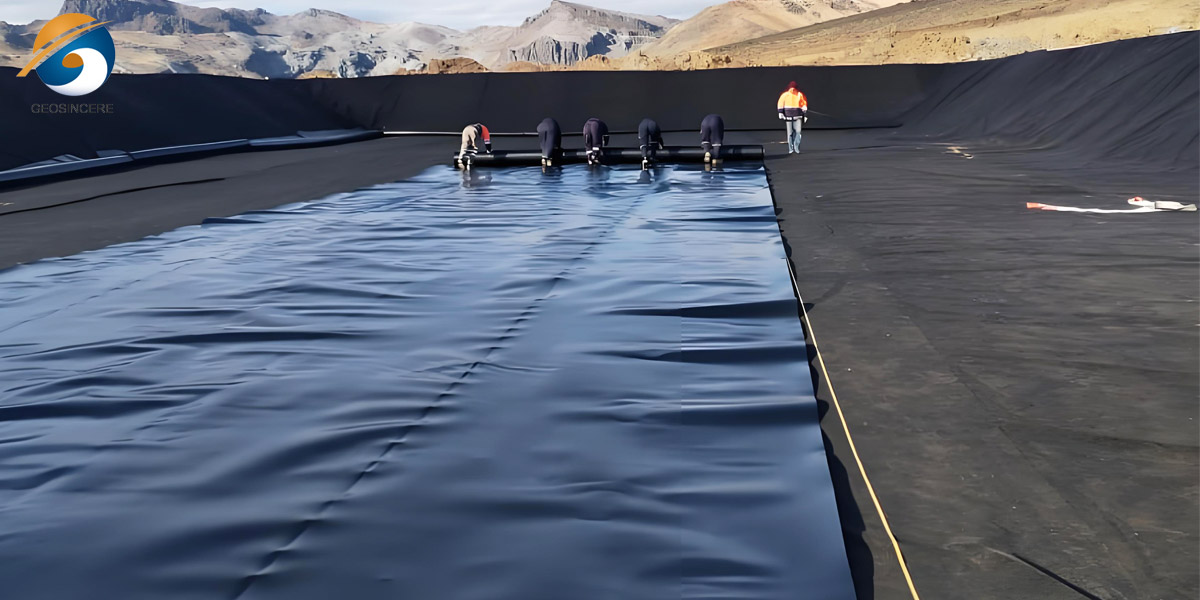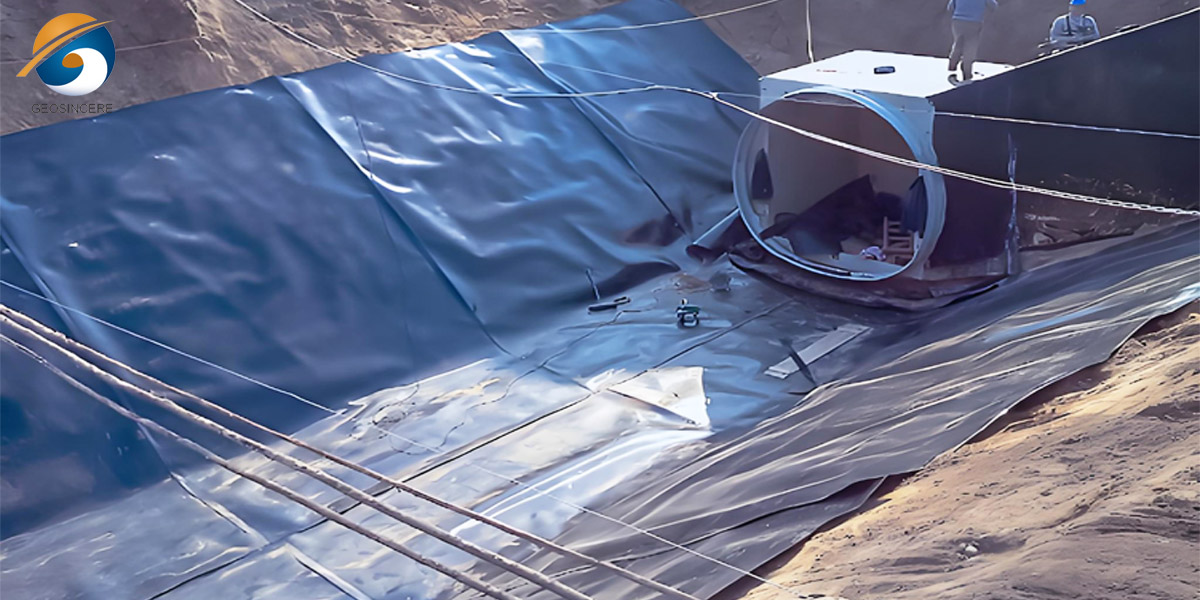What Are the Advantages of Geomembrane 500 Micron?
In present day engineering and environmental safety projects, the use of geosynthetic substances has turn out to be indispensable. As an essential member of geosynthetics, geomembranes are broadly used in water conservancy projects, landfills, mining, agricultural ponds, and transportation infrastructure due to their fantastic impermeability and durability.
Among a variety of specifications, the Geomembrane 500 micron has grow to be the favored desire for many tasks due to the fact of its reasonable thickness, bendy installation, and cost-effectiveness. So, what are the blessings of Geomembrane 500 micron, and why is it broadly used in the worldwide market? This article will systematically discover its advantages from the views of performance, application, cost, construction, and environmental protection.
1. Basic Characteristics of Geomembrane 500 Micron
1.1 Geomembrane 500 Micron Material Composition
Geomembranes with a thickness of 500 microns are generally manufactured from high-density polyethylene (HDPE) or linear low-density polyethylene (LLDPE) using advanced extrusion or calendering techniques. These polymers are selected for their excellent chemical resistance, UV stability, and mechanical strength, making them suitable for applications in harsh environments such as landfills, mining sites, reservoirs, and industrial containment. The high-quality raw materials and precise production process ensure consistent thickness, durability, and long-term performance.
1.2 Geomembrane 500 Micron Physical Properties
Thickness: 0.5 mm (500 microns), providing an effective barrier against water and chemical leakage.
Density: 0.94–0.96 g/cm³ (HDPE), ensuring a balance of strength and flexibility.
Surface: Smooth and low-friction, which facilitates installation, welding, and reduces abrasion during handling.
Standard Dimensions: HDPE liner Rolls typically come in widths of 2–8 meters and lengths of 50–100 meters, allowing customization for various project scales and terrains.
1.3 Geomembrane 500 Micron Mechanical Performance Indicators
Tensile Strength: ≥20 MPa in both longitudinal and transverse directions, providing reliable resistance against stretching and structural stresses.
Elongation at Break: ≥700%, allowing the membrane to deform under load without tearing, which is critical for ground settlement or shifting soil.
Tear Strength: ≥62 N/mm, ensuring puncture resistance during transportation, installation, and long-term use.
CBR Puncture Resistance: ≥160 N, offering protection against sharp objects or uneven subgrade, making it suitable for landfill liners, pond liners, and industrial containment applications.
This combination of chemical stability, mechanical strength, and flexibility makes 500-micron geomembrane liner an ideal choice for a wide range of civil, environmental, and industrial projects.
2. 8 Core Advantages of Geomembrane 500 Micron
2.1 Excellent Impermeability
With a thickness of 0.5 mm, the hdpe geomembrane presents an relatively impermeable barrier. Its permeability coefficient is as low as 1×10⁻¹³ cm/s, efficiently stopping the penetration of beverages and gases. This overall performance is equal to a number of meters of compacted clay, but solely requires a skinny and light-weight membrane layer.
2.2 Superior Chemical Stability
Made from HDPE, the geomembrane sheet well-knownshows extremely good resistance to chemical corrosion. It can face up to acids and alkalis (pH 1–14), natural solvents, salt solutions, and microbial degradation. This steadiness ensures dependable overall performance in harsh industrial and environmental conditions.
2.3 Outstanding Mechanical Strength
Despite being solely 0.5 mm thick, the hdpe membrane keeps excessive mechanical strength. It provides excessive tensile resistance, puncture resistance, and the potential to adapt to uneven basis settlement, making it appropriate for landfills, reservoirs, ponds, and industrial containment projects.
2.4 Easy Installation
The clean floor and light-weight plan simplify construction. The membrane is flexible, effortless to transport, and adaptable to a range of terrains. In addition, it gives super welding overall performance with excessive seam strength, making sure tightly closed set up and long-term durability.
2.5 Cost-Effectiveness
Compared to thicker hdpe geomembrane liner, the 0.5 mm model provides sizeable fee advantages:
Material price is decreased by means of 20–30%
Lighter weight lowers transportation charges by way of 40–50%
Construction effectivity is accelerated by using over 30%
2.6 Environmental Adaptability
The impermeable geomembrane performs reliably in severe temperatures ranging from -60°C to 80°C. Its UV resistance, more suitable by way of carbon black and anti-aging additives, approves a provider lifestyles exceeding 50 years. Non-toxic and environmentally friendly, it meets food-grade requirements and is secure for potable water projects.
2.7 Consistent Quality
Advanced manufacturing strategies make sure steady exceptional and uniform performance:
Thickness deviation managed inside ±3%
Smooth and uniform surface
Stable bodily overall performance indications for dependable engineering applications
2.8 Environmentally Friendly
HDPE substances are non-toxic and harmless, assembly environmental requirements and protected for direct contact with ingesting water. The impermeable geomembrane liner additionally prevents water leakage, lowering aid waste and aiding sustainable development.
3. Geomembrane 500 Micron Main Applications
3.1 Geomembrane 500 Micron for Water Conservancy Projects
Reservoirs: The geomembran 500 micron acts as an positive water-resistant barrier, stopping water leakage and enhancing typical water retention and utilization.
Canal Lining: Reduces water loss alongside irrigation canals, ensuring environment friendly transport of water to agricultural fields and enhancing irrigation efficiency.
Embankments: HDPE dam liners enhances seepage resistance, stabilizes slopes, and will increase the typical security and sturdiness of embankment structures.
3.2 Geomembrane 500 Micron for Environmental Engineering
Landfills: Serves as a dependable liner to stop leachate from contaminating surrounding soil and groundwater, making sure environmental safety.
Wastewater Treatment Plants: Used in rules tanks and sedimentation basins to comprise liquids, stop leakage, and hold operational efficiency.
Hazardous Waste Disposal Sites: Isolates hazardous substances, decreasing environmental have an impact on and defending ecosystems from chemical contamination.
3.3 Geomembrane 500 Micron for Agriculture
Aquaculture Ponds: Prevents water seepage, making sure regular water degrees for fish and shrimp farming.
Irrigation Systems: Improves water use effectivity through minimizing losses via soil infiltration.
Biogas Digesters: Enhances gasoline series effectivity and ensures secure containment of natural materials.
3.4 Geomembrane 500 Micron for Construction Projects
Basement Waterproofing: Prevents groundwater infiltration and structural damage, extending the lifespan of buildings.
Green Roofs: Provides dependable water-proof safety for sustainable rooftop gardens and landscaping.
Artificial Lakes: Creates aesthetic water aspects whilst keeping water ranges and stopping seepage.
3.5 Geomembrane 500 Micron for Mining Projects
Tailings Ponds: Prevents heavy steel and chemical air pollution from contaminating the surrounding environment.
Heap Leach Pads: Enhances aid restoration effectivity whilst controlling leakage of system liquids.
Mine Backfill: Prevents contaminant migration, defending surrounding soil and water bodies.
4. Geomembrane Technical Parameter Comparison
Thickness | Features | Suitable Scenarios |
0.3mm | Lowest cost, highly flexible, lower durability | Temporary ponds, small projects |
0.5mm | Excellent impermeability, easy installation, cost-effective | Agricultural ponds, landscape projects, wastewater ponds |
≥1.0mm | Higher strength, longer lifespan, higher cost | Landfill liners, large reservoirs |
The 0.5mm thickness strikes a balance between impermeability and cost efficiency.
5. Geomembrane 500 Micron Construction Requirements
5.1 Subgrade Preparation
Proper subgrade preparation is critical for the long-term performance of the geomembrane. The surface should be smooth and flat, with unevenness controlled within ≤30 mm per 2 meters. The soil must be compacted to at least 90% of the standard Proctor density to ensure stability. All sharp objects, stones, roots, and debris must be completely removed to prevent punctures or damage to the membrane during installation.
5.2 Laying Process
Geomembrane installation should be carried out within a temperature range of 5–40°C to ensure optimal flexibility and weld performance. The membrane should be laid in the direction of slopes or water flow to facilitate drainage and reduce stress on seams. Additionally, allowance must be made for thermal expansion and contraction, typically about 1–2% of the length, to prevent wrinkling or tearing under temperature fluctuations.
5.3 Welding Technology
High-quality welding is essential to maintain the impermeability of the membrane. Common methods include:
Double-track hot wedge welding, with temperatures between 280–320°C, suitable for long seams.
Extrusion welding, used for complex areas, corners, or repair works.
All welded seams must undergo quality inspection, including air pressure tests, vacuum tests, or ultrasonic inspections, to ensure airtightness and structural integrity.
5.4 Protection Measures
To extend the service life of the geomembrane, appropriate protection is necessary:
Cover the membrane with a protective layer such as geotextile, sand, or soil to prevent mechanical damage.
Avoid prolonged exposure to sunlight during construction; timely coverage is essential to reduce UV degradation.
Proper edge anchoring is required to maintain stability, prevent displacement, and ensure the membrane remains secure under wind, water flow, or soil movement.
6. Geomembrane 500 Micron Economic Benefits
6.1 Direct Cost Savings
Material cost: ~35% less than 0.75mm geomembrane
Transportation: lighter weight reduces shipping costs
Construction: higher efficiency lowers labor costs
6.2 Indirect Benefits
Shorter project duration: earlier operation creates value
Low maintenance: long service life reduces maintenance costs
Environmental benefits: prevents pollution, lowers environmental remediation costs
6.3 ROI Analysis
Payback period: typically 2–3 years
Lifetime benefits: 5–10 times the initial investment
7. Advantages of GEOSINCERE Geosynthetics Geomembrane 500 Micron
As a professional geosynthetic supplier, GEOSINCERE Geosynthetics provides high-quality Geomembrane 500 microns:
International Certification: ISO, CE, SGS certified, compliant with global engineering standards
Strict Quality Control: each roll is tested for airtightness, impermeability, and tensile strength
Customizable Dimensions: widths 2–8m and lengths tailored to reduce seams
Professional Support: construction guidance, welding plans, and long-term technical assistance
Global Supply: exported to over 50 countries in Asia, Europe, Africa, and South America
8. Geomembrane 500 Micron Frequently Asked Questions
8.1 Is 0.5mm thick enough?
Yes, for most engineering applications, 0.5mm is sufficient. Only for heavy-duty projects might thicker options be considered.
8.2 What are the advantages of a smooth surface?
Reduces friction for easier installation and enhances impermeability.
8.3 What is the service life?
Up to 50 years under normal conditions.
8.4 How is welding quality ensured?
Through professional welding equipment, trained personnel, and strict quality inspection protocols.
9. Geomembrane 500 Micron Customer Case Studies
Case 1:
One of the largest shrimp farming aquaculture companies in the Middle East selected GEOSINCERE Geosynthetics as their trusted partner after a thorough two-year approval process. The company designed and constructed over 1,000 ponds at the Khuweymah Shrimp Farm in South Sharaqiya, a flagship project in the region.
For this ambitious project, GEOSINCERE Geosynthetics supplied high-performance geomembranes with advanced UV resistance and an extended lifespan. These geomembranes are specifically engineered to:
Enhance production efficiency
Maintain healthy shrimp and fish populations
Prevent environmental contamination
This collaboration underscores GEOSINCERE Geosynthetics's commitment to delivering innovative and reliable solutions for the aquaculture industry.
Case 2:
Client is the leading seafood and the largest vannamei company in Sri Lanka, the client’s vision is to produce seafood with impeccable freshness and quality.Through communication and negotiation, GEOSINCERE Geosynthetics client chose 0.5mm GM 13 standard geomembrana HDPE liner finally.
According to customer's request our company arranged three workers to install the first batch of geomembranes on site and taught local workers how to weld them.
Since 2018,GEOSINCERE Geosynthetics Geosynthetics had provided more than 300,000 square meters geomembrana HDPE liner, 20 sets welding machine and 20,000 m geolock for aquaculture farm project in Sri Lanka
10. Conclusion
Geomembrane 500 Micron combine excellent impermeability, strong mechanical strength, cost-effectiveness, and wide applicability, making them indispensable in modern engineering. Choosing the right geomembrane requires considering project requirements, environmental conditions, and economic factors.
Shandong Geosino New Material Co., Ltd. (GEOSINCERE Geosynthetics) is committed to providing the highest quality geomembranes and professional technical services. For any inquiries or needs regarding Geomembrane 500 microns, contact our technical team for comprehensive support and solutions.








